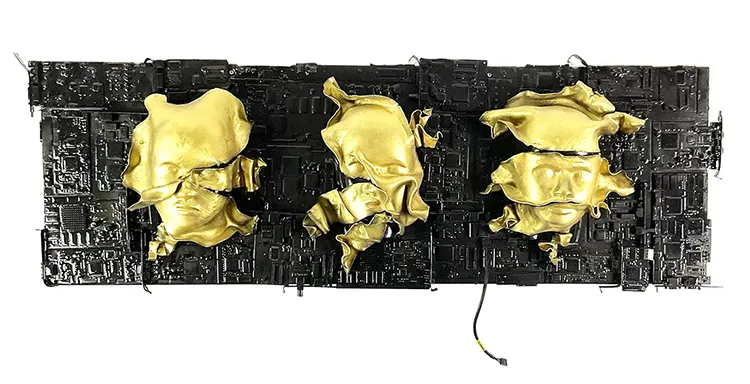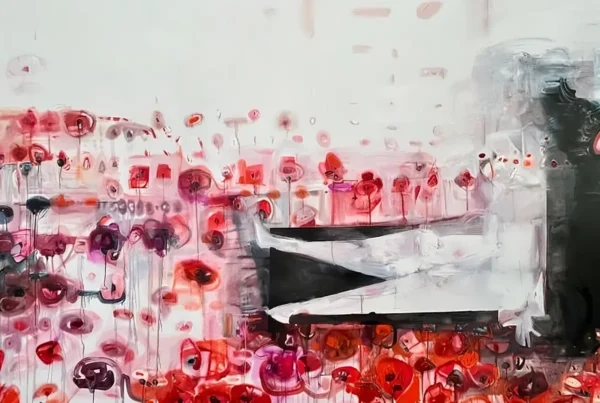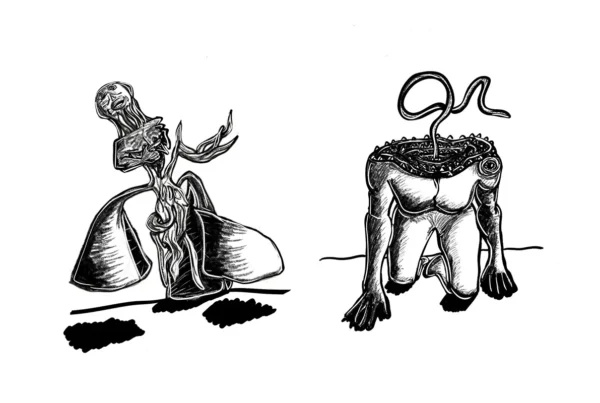“Art is my weapon of choice for confronting the future.”
From Provincial Town to Global Canvas
Noa Ry, a seasoned artist whose life began in the quaint corners of a Swiss provincial town, stands today as a formidable figure in the art world. Born into a patchwork family residing in a commune-like setting, Ry’s early exposure to the dual worlds of technology and human interaction came from her father, who was an early computer enthusiast. This unique upbringing laid a foundational perspective that has influenced her artistic journey significantly. At the tender age of 16, Ry embarked on her formal education in the arts, which continued until she was 20, culminating in a master’s degree in cultural studies at 27. This academic pursuit opened her eyes to the possibilities of forging new paths in the cultural discourse, encouraging her to develop new terms and concepts to better articulate the fragmented identities of the 21st century.
Ry’s artistic philosophy has been significantly shaped by her educational background and her early life experiences. The integration of cultural studies into her art has allowed her to explore and express the complexities of identity in contemporary society. Through her art, she aims not just to reflect the world as it is but to challenge and expand the ways in which we understand and engage with it. Her approach is one of evolution and reinvention, consistently pushing the boundaries of traditional art to incorporate and reflect the technological advances and cultural shifts that characterize modern life.
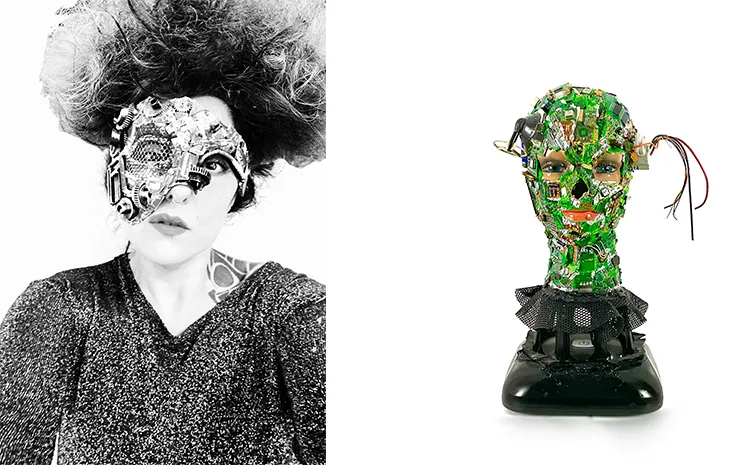
Noa Ry: The Intersection of Art and Identity
Noa Ry’s journey into the world of art was as much a necessity as it was a calling. Living with schizoaffective disorder, Ry experiences a world that is perpetually splintering and reconfiguring, filled with voices and visions unseen and unheard by others. This internal chaos, however, has not only fueled her creative drive but has also become a central theme in her work. Art for Ry is not just a form of expression but a vital coping mechanism that allows her to manifest her inner turmoil into tangible forms, helping her navigate through her complex inner world. The struggle between the inner self and the external reality, the fragmentation of identity, and the merging of disparate elements define the core of her inspiration.
The synthesis of technology and human experience is another recurring theme in Ry’s oeuvre. Influenced by her fascination with the merging of technology and human flesh since her teenage years, Ry’s works often challenge the conventional boundaries of art. She explores the concept of the Divorg, a term she coined to describe a ‘dividing organism’ that reflects the constant state of flux in human identity within the information age. This concept is a direct response to traditional views of technology as a threatening force, proposing instead that technology is an integral and inevitable extension of human capability. Through her art, Ry engages deeply with these themes, using her unique perspective to provoke thought and dialogue about the evolving relationship between humans and technology.
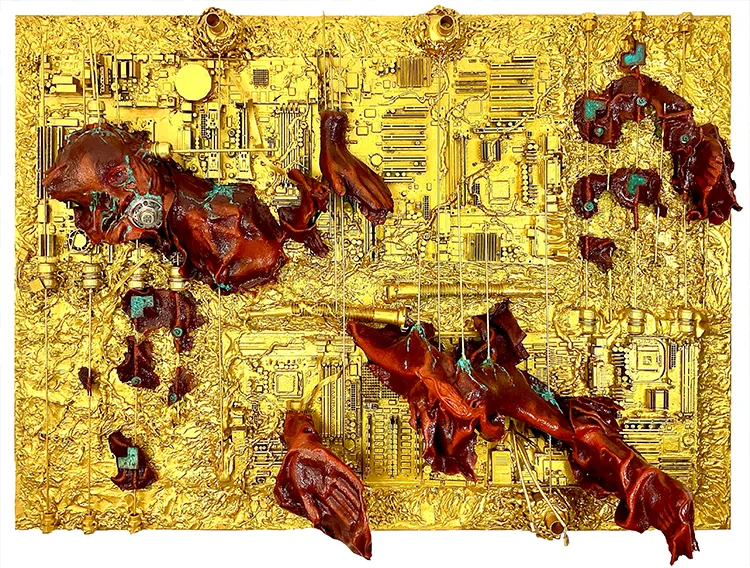
Merging Dimensions in a Compact Space
Noa Ry’s artistic workspace is as unconventional as her approach to art. Operating from a small corner of her apartment, where half of her dining table serves as her studio, Ry challenges the notion that artists require large, dedicated spaces to create impactful work. This modest setup does not hinder her creativity; instead, it underscores her ability to adapt and thrive within her means. Her environment is a testament to her belief in the fluidity of artistic creation—she does not confine herself to a specific setting or ambiance to inspire her creativity. For Ry, the essential elements are not bound by physical space but by her ability to maintain a clear mental and visual connection to her works. This freedom allows her to fully immerse herself in her process, ensuring that her focus remains squarely on the art itself, not the place of its creation.
Noa Ry feels that the medium chooses her. She views herself more as a channel for her ideas, creating 3D paintings, digital drawings, sculptures, video art, and robotic art. This diversity is fundamental to her practice; she sets no limits on the choice of medium. Ry believes there are no “mistakes” in her work. Instead, she embraces errors, considering them the soul of storytelling. Her unrestricted approach to art allows her to fully explore and express her creative vision, turning what might be seen as flaws into integral parts of her narrative. This philosophy not only enriches her work but also invites viewers to find beauty and meaning in imperfection. By transforming errors into opportunities, Ry’s art becomes a dynamic process of discovery and reinvention, reflecting the ever-evolving nature of human experience and creativity.

Noa Ry: Influences and Innovations
Among the various influences in Ry’s life, her condition perhaps shapes her creative landscape most distinctly. The internal visions and voices that accompany her schizoaffective disorder are not just symptoms but sources of inspiration, driving her to explore the realms of the abstract and the surreal. Alongside this deeply personal muse, artists like Daniel Arsham, Pippilotti Rist, and Nam June Paik have played significant roles in shaping her artistic vision. These artists, known for their innovative use of media and exploration of technology in art, resonate with Ry’s quest to blur the lines between the digital and the physical, the real and the imagined.
One of Ry’s notable works, “Golden Age,” exemplifies her unique synthesis of these influences. This piece features three heads, each representing different facets of identity, set against a backdrop of computer circuit boards—symbolizing the pervasive technological landscape that underpins modern existence. Not merely content with static expression, Ry ventured into digital mediums, creating an animated version of “Golden Age.” In this digital rendition, the heads come to life, animated with Ry’s own facial expressions, adding a deeply personal and dynamic layer to the piece. This transition from physical to digital formats represents a key aspect of her artistic exploration, reflecting her belief in the fluidity between various forms of existence—be they analog, digital, or somewhere in between. Through such works, Ry not only questions but also celebrates the complex interplay of technology and human identity, offering a multi-dimensional view that challenges viewers to reconsider their perceptions of self and society.
Ry’s biggest dream is to install a conveyor belt at a solo exhibition of her own. She envisions people being guided past her artworks at the conveyor belt’s own speed, with stops at certain intervals. By depriving viewers of their own pace, she aims to reflect the relentless flow of information in today’s world, where control over this flow is often lost. This dynamic installation would symbolize the conflict between the desire for control and the reality of powerlessness, mirroring the challenges Ry faces daily. Through this, she hopes to confront audiences with a tangible experience of losing control, provoking them to reflect on their own interactions with the rapid pace of modern life.
